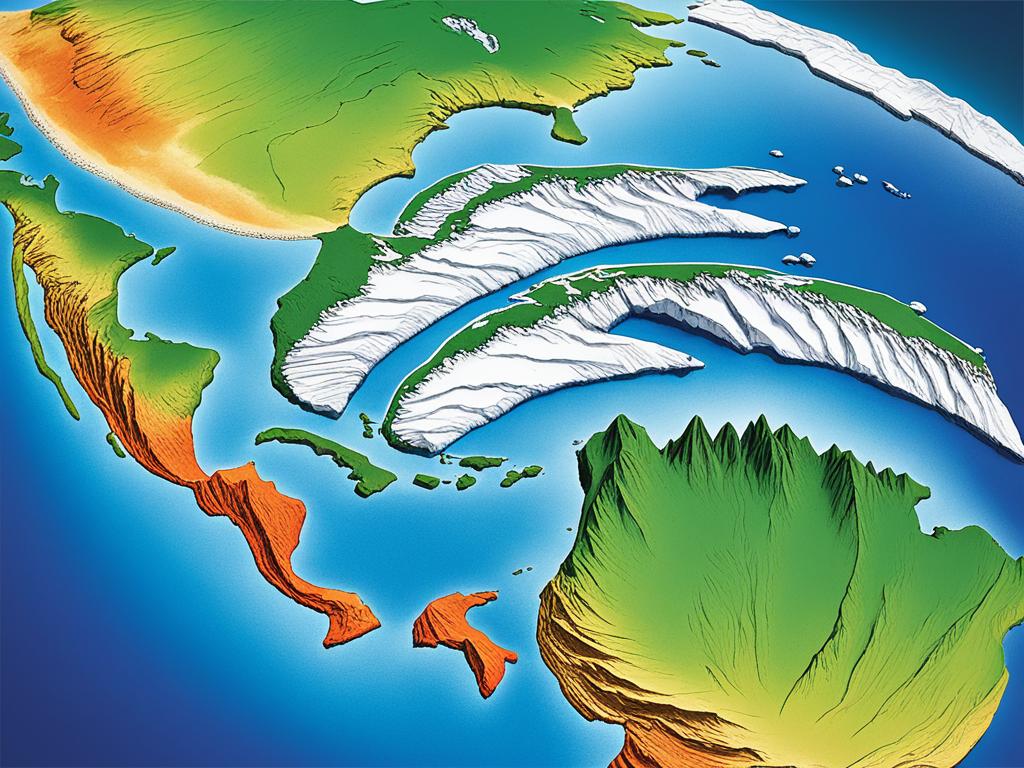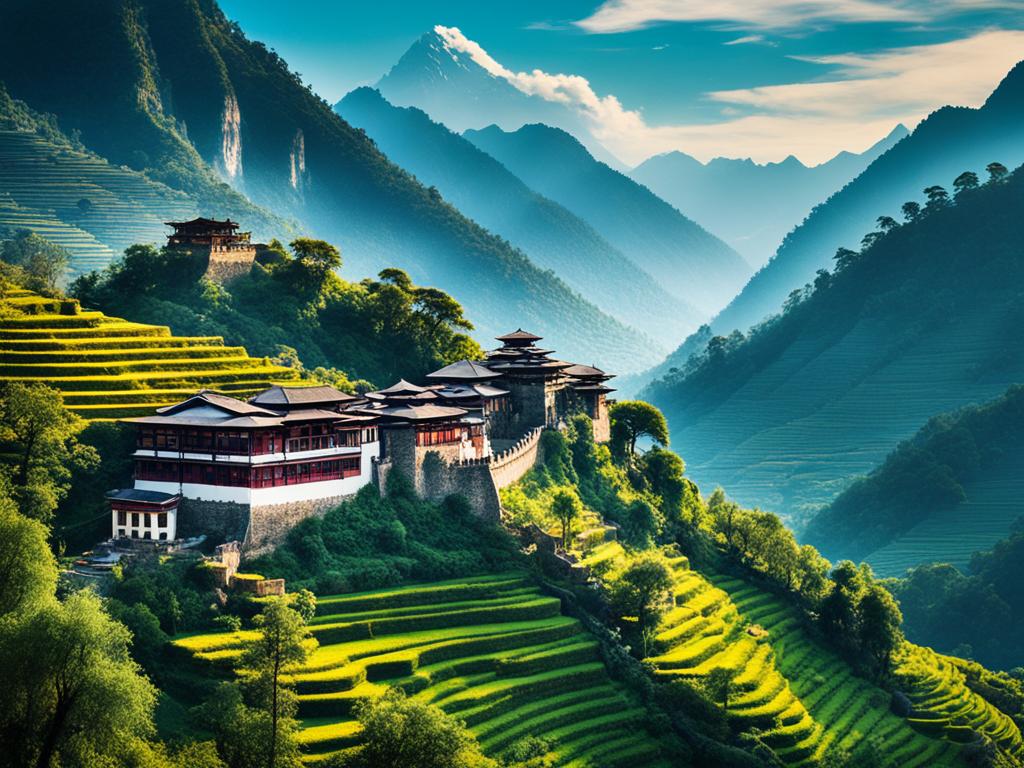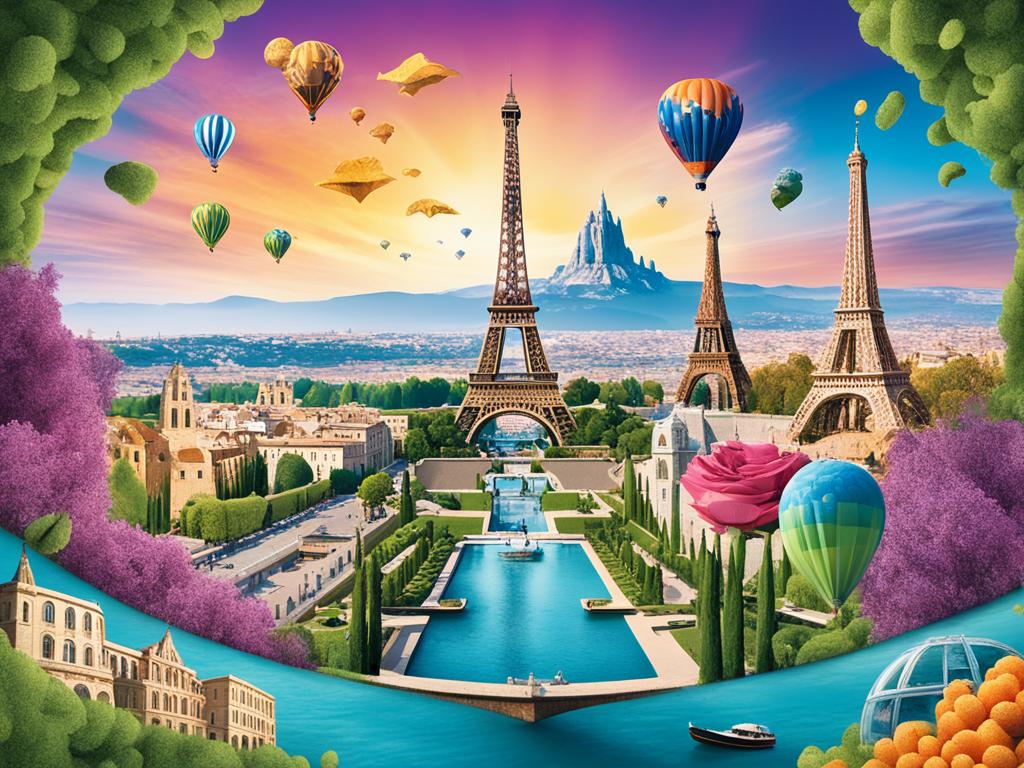The Earth is made up of seven main continents. Each one is known for its special landforms, cultures, biodiversity, and natural wonders. These continents, from the biggest to the smallest, are Asia, Africa, North America, South America, Antarctica, Europe, and Australia. The continents cover about 29% of Earth’s surface. The oceans cover the rest.
Some geographers group the continents differently. They might say there are four big land areas: Afro-Eurasia, America, Antarctica, and Australia. The way we think of continents can change. This depends on how we look at the world, be it through geology, history, or culture. No matter how we group them, each continent is unique. They surprise us with their different landforms, habitats, people, and natural wonders.
Key Takeaways
- The Earth’s landmass is divided into seven main continents, with Asia being the largest and Australia the smallest.
- Continents are defined by their continental shelves and can also be grouped into four primary landmasses based on geological and cultural criteria.
- The world’s continents exhibit remarkable diversity in their landscapes, climates, ecosystems, and indigenous cultures.
- Continents occupy about 29% of the Earth’s surface, with the remaining three-fourths covered by the vast oceans.
- The number of recognized continents can vary depending on the specific criteria used to define them.
What is a Continent?
A continent is one of Earth’s seven main landmasses. These are separated by big oceans or other natural barriers. They are known by what their land looks like and a mix of geology and culture.
Defining Continents
Some experts use Earth’s tectonic plates to define continents. But some look at history and culture. This is why continental boundaries can be hard to map out clearly.
Geological and Cultural Criteria
Things like land size, being separated by water, geological makeup, and cultural history are used in defining continents. The many ways we do this shows how complex describing continents can be.
Continents are full of unique land, climates, people, and amazing places to see. This makes them very interesting for anyone learning about Earth’s geography.
How Many Continents are There?
There isn’t just one answer for the number of continents we have. Some say there are four because they combine Afro-Eurasia into one. Others think there are seven, counting Africa, Asia, Europe, and others separately. This debate over how many continents there are will go on. Yet, many countries and organizations go with the seven-continent view. This includes Asia, Europe, and others as unique places.
| Continent Model | Number of Continents | Continents Recognized |
|---|---|---|
| Four Continent Model | 4 | Afro-Eurasia, America, Antarctica, Australia |
| Seven Continent Model | 7 | Africa, Antarctica, Asia, Australia, Europe, North America, South America |
The seven continent model is widely used to split the world into pieces. It sees Europe and Asia as different places, even though they connect. This model helps us understand the world in simpler terms. It is used by many to teach about Earth’s continents. We see it in maps and learn about each continent’s unique qualities.
Four Continent Model
The four continent model looks at the biggest, connected landmasses. It places Europe, Asia, and Africa together in Afro-Eurasia. North and South America become just America. Then, Antarctica and Australia are the last two big land areas.
This model highlights the large parts of the world that are split by big oceans. It groups the normal continents into fewer big areas. This makes it simpler to see Earth’s main lands.
| Continent | Land Area (sq km) | Percentage of Global Landmass | Estimated Population | Percentage of World Population |
|---|---|---|---|---|
| Afro-Eurasia | 75,000,000 | 51% | 5,920,000,000 | 77% |
| America | 42,000,000 | 28% | 1,010,000,000 | 13% |
| Antarctica | 14,200,000 | 9% | 0 | 0% |
| Australia | 8,600,000 | 6% | 43,000,000 | 0.6% |
This model shows Earth’s biggest, separate land masses and the big oceans between them. It underlines the importance of the global oceans. They keep the main land areas apart.

Seven Continent Model
The seven continent model is well-known for dividing the world’s land into seven parts. Europe and Asia are seen as different continents, even though they sit on the same tectonic plate. This is because they have different histories and cultures. North and South America are also viewed as separate, linked only by a thin strip of land in Panama. This model names the seven major land areas as Africa, Antarctica, Asia, Australia, Europe, North America, and South America.
This way of thinking explains the Earth’s division into seven parts very well. It looks at the unique features of each continent in terms of geology, history, and culture. This helps us understand the variety of our planet’s people and landscapes better.
Overview of the World’s Continents and Their Unique Features
The world’s continents show a lot of different things. They have various land forms, cultures, and natural sights. Together, they take up about 148 million square kilometers (57 million square miles).
Asia is the biggest continent. It has both rich and poor countries. Here, over 2,300 languages are spoken. Africa is where life likely began. It has a rich mix of cultures because of its history with colonization.
North America is known for its big plains and mountains. It has many followers of Christianity. South America is famous for the Andes Mountains and the Amazon Rainforest. It’s also known for its many plants and animals.
Europe is very rich and has small but varied countries. Australia/Oceania is the smallest, with many islands in the Pacific Ocean. Antarctica is all ice. It has a lot of Earth’s fresh water.
The continents show us amazing natural places, different cultures, and cool geology. They keep us all interested and inspired.
Asia: The Largest Continent
Asia is the world’s largest continent, covering about 30 percent of Earth’s land. It’s home to over 4.6 billion people, making it the most populous. Asia blends many cultures and geographies, making it complex but fascinating.
Diverse Languages and Cultures
Asia shines in its variety of languages. It has over 2,300 languages, showcasing a rich history and cultural mix. Many ethnic groups have thrived here for thousands of years, adding to this diversity.
Home to Richest and Poorest Nations
Asia’s wealth ranges from the very rich to the extremely poor. Some countries like Qatar and Saudi Arabia have great wealth from their oil. On the other hand, Asia also sees poverty in some areas, showing stark economic differences within the continent.

Africa: The Cradle of Humankind
Africa is known as the “cradle of humankind” because the oldest human fossils were found there. Paleontologist Raymond Dart is a key figure. He found an extinct ape-like species in 1925. He named this species Australopithecus africanus. It was seen as a link between early apes and humans.
Diverse Geography and Natural Wonders
Africa is also famous for its varied land and natural beauty. It boasts the world’s longest river, the Nile, and the second-highest waterfalls, the Tugela Falls in South Africa. There are 54 countries in Africa, each with its own unique landscapes and wildlife.
Colonial History and Diverse Cultures
But, Africa’s past also includes a time of European colonialism. From the 15th to 19th centuries, European powers took control over most of the continent. Despite this, Africa has developed rich and diverse cultures. It ranges from the Maasai people, known for their nomadic lifestyle, to the Bambuti communities, who are politically active in Central Africa.
North America: Vast Plains and Towering Mountains
North America is the third-largest continent, stretching far from the northwest’s Aleutian Islands to the south’s Isthmus of Panama. It is known for its diverse geography. There are young mountain ranges like the Rockies in the west. And older, worn-down ones are near the East Coast. Fertile plains are between these towering peaks. They are crucial for agriculture and development across North America.
The Largest Christian Population
North America stands out for having a significant Christian community. About 80% of people in Canada, the United States, and Mexico call themselves Christian. This shows Christianity’s deep connection with the continent.
Diverse Indigenous Cultures
Aside from its Christian roots, North America is also celebrated for its varied indigenous cultures. This includes the ancient Maya civilization from Central America and Mexico. These cultural heritages have continued despite the impacts of colonization. They add richness to North America’s cultural fabric.
Europe: The Wealthiest Continent
Europe is known as the richest and most economically advanced continent. Yet, it has areas with poverty, especially in its eastern part. Europe is where you can find some of the world’s tiniest countries. This includes places like Vatican City, Monaco, and others, as per the second source.
Europe might be small, but it holds 44 countries, making it very diverse. It’s set apart from Asia, even though they are on the same tectonic plate. This is because Europe has its own rich history and culture. This mix of economic strength, a variety of politics, and small countries makes Europe truly unique and complex.

Home to Smallest Countries
Along with its wealth, Europe is famous for having many of the world’s smallest countries. Places like Vatican City and Monaco prove this. They add to the continent’s colorful mix of people and economics.
South America: Land of Superlatives
South America, from the north by the Caribbean Sea to the south’s Tierra del Fuego, is stunning. Its features include the majestic Andes Mountains and the vast Amazon Rainforest. It also houses a diverse biodiversity and rich cultural heritage.
Andes Mountains and Amazon Rainforest
The Andes Mountains are the world’s longest range, going through South America. They have peaks like Argentina’s Aconcagua, standing at 6,961 meters. This range offers a variety of ecosystems, from Chile’s Atacama Desert to Colombia’s cloud forests.
The Amazon Rainforest spans almost 40% of the continent. It’s the biggest tropical rainforest, known for its diverse wildlife. It gets its life from the mighty Amazon River, 6,437 kilometers long.
Rich Biodiversity and Cultural Heritage
South America is a haven for unique plant and animal life. Creatures like jaguars and Andean condors are found here. It’s also home to the Amazon river dolphin and giant anteater.
The area’s cultural history is deep, with the Inca civilization and other groups influencing it. The continent’s 433 million people speak different languages and follow various beliefs. Most are Christians.
Exploring South America means trekking the Andes, visiting the Amazon, and experiencing its cultures. It’s a land full of the most amazing sights and experiences.
Australia/Oceania: The Smallest Continent
Oceania, where Australia is, is seen as the globe’s tiniest continent when land comes into play. It includes lands like Australasia and Polynesia. Still, Australia stands out as the biggest within this area. It’s known for being surrounded by the Pacific Ocean, fulfilling the criteria of a separate continental body.
The area is made up of many islands and states, like New Zealand and Vanuatu, with about 43 million residents. Despite its size, Australia is also where you find the most people. This shows the interesting mix of being a small continent amidst the Pacific’s great vastness.
Australia/Oceania’s landscapes vary greatly. You’ve got the massive continental islands next to smaller ones like Zealandia. Plus, you’ll find regions like Melanesia, known for both its height and volcanic mountains.
However, in places like Micronesia and Polynesia, the islands are mostly low-lying and made of coral. Here, places like Kwajalein Atoll and Kiribati stand out. The waters around Oceania are split into three zones. Each houses different kinds of life, making it a rich area for biodiversity.
The Great Barrier Reef is a standout feature in Australia. It’s the planet’s biggest coral system at 344,400 square kilometers. This reef, alongside the New Caledonia Barrier Reef, is a hub for marine life. Whales, dolphins, turtles, and many other species call it home.
Oceania is full of unique plants and animals, thanks to its isolation and varied climates. Even though it’s the smallest, this area has a lot to offer in terms of its environment. It truly is a special and important part of our Earth.
Antarctica: The Frozen Continent
Antarctica is at the planet’s southern end. It’s the smallest continent by population. No one lives there permanently. Yet, it’s the biggest in terms of ice coverage. It has 90% of the world’s ice and adds 60-70% to our freshwater. Covered in ice, it’s the coldest, driest, and windiest place on Earth.
This continent’s unique features make it stand out. It has an average height of 2,000 meters. The Transantarctic Mountains have peaks over 4,500 meters high. It’s filled with tall glaciers and ice sheets. Some parts get very little snow, making it one of the driest deserts. Yet, it’s a frozen wonderland.
Antarctica isn’t a place for many people. But, it has research stations where scientists work. In winter, about 1,000 scientists live there. In summer, the number jumps to 5,000. They explore the ice, climate, and nature. They help us learn more about Antarctica, this unique part of the world.
Source Links
- https://education.nationalgeographic.org/resource/Continent/
- https://kids.britannica.com/students/article/continent/273790
- https://en.wikipedia.org/wiki/Continent
- https://www.britannica.com/science/continent
- https://www.geographyrealm.com/continents/
- https://www.nationalgeographic.org/encyclopedia/asia/
- https://www.britannica.com/place/Asia
- https://www.smithsonianmag.com/science-nature/how-africa-became-the-cradle-of-humankind-108875040/
- https://www.nationalgeographic.org/encyclopedia/africa-human-geography/
- https://www.britannica.com/place/North-America
- https://testbook.com/static-gk/7-continents
- https://www.nationalgeographic.org/encyclopedia/europe-resources/
- https://kids.britannica.com/kids/article/Europe/353110
- https://en.wikipedia.org/wiki/Europe
- https://www.kids-world-travel-guide.com/south-america-facts.html
- https://en.wikipedia.org/wiki/South_America
- https://education.nationalgeographic.org/resource/oceania-physical-geography/
- https://education.nationalgeographic.org/resource/oceania-human-geography/
- https://education.nationalgeographic.org/resource/antarctica/
- https://discoveringantarctica.org.uk/oceans-atmosphere-landscape/ice-land-and-sea/key-physical-features/


